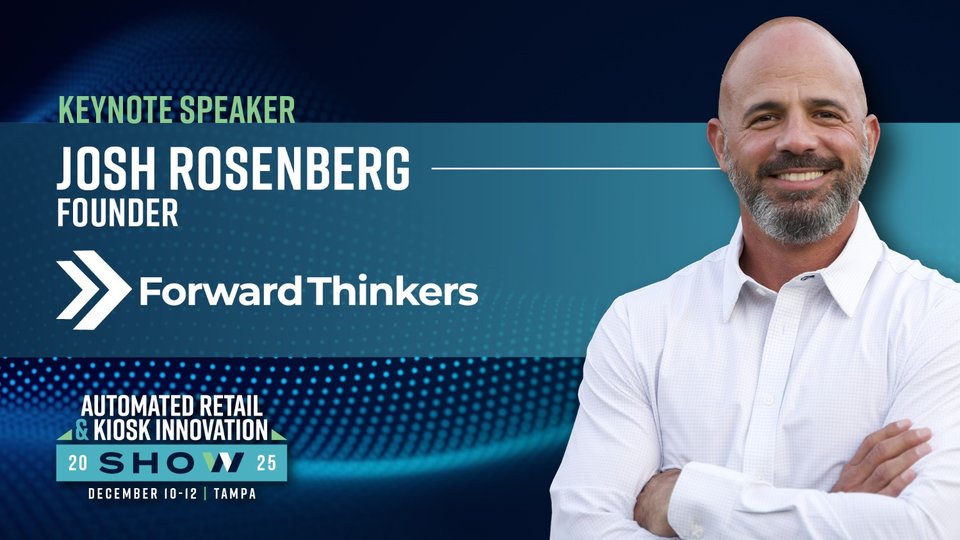Automated Retail & Kiosk Innovation Show
Keynote speaker Josh Rosenberg shares insight on his upcoming session at the 2025 Automated Retail and Kiosk Innovation Show, where he’ll discuss how operators can transform transactional convenience into lasting brand relationships.

Photo: Networld Media Group
August 15, 2025 by Sandra Carpenter — Editor, Networld Media Group
This December 10-12, industry leaders and innovators will gather in Tampa for the Automated Retail & Kiosk Innovation Show, an event focused on the latest advancements in self-service and unattended retail.
The show offers a deep dive into how businesses can leverage cutting-edge technologies, including kiosks and automated vending, to expand their reach, reduce operational costs and enhance the customer experience.
Attendees can look forward to seeing the newest solutions in action, connecting with industry experts and gaining insights to implement successful strategies.
Among the keynote sessions is «The Experience Shift: How Self-Service Can Win by Curating, Not Just Automating.»
 |
Photo: Josh Rosenberg, founder, Forward Thinkers |
The session will be led by Josh Rosenberg, founder of Forward Thinkers and a leadership expert with a deep industry background that includes 18 years in executive leadership roles at The Coca-Cola Company, spanning sales, operations and brand strategy. With his extensive experience in building successful business strategies and his collaborative approach to coaching, Rosenberg brings a unique perspective to the world of automated retail.
In his session, Rosenberg will guide attendees to look beyond a simple location-by-location approach and adopt a broader «live, work, play» mindset. He will share his expertise on aligning brand, equipment, messaging and overall experience to meet modern consumer expectations. Kioskmarketplace reached out to Rosenberg via an email interview to get a preview of his talk and his insights on how to achieve this «experience shift.»
Q: Could you elaborate on what you mean by «curating» and how that differs from simply automating?
Rosenberg: When we talk about automation, we’re typically referring to removing friction — making the transaction fast, touchless and efficient. That’s foundational. But it’s no longer enough. Today’s consumer expects more than access — they expect relevance. That’s where curation comes in.
Curation is about crafting a retail experience that feels intentionally built for the consumer in that specific moment, in that specific place. It means selecting the right products, price points, formats and packaging — and even equipment — that align with the environment and consumer behavior. You don’t stock a multi-family lobby the same way you stock a transit hub or workplace breakroom.
We’ve moved beyond the one-size-fits-all planogram. Consumers now shop with expectation, not hesitation. They’re looking for their brands, their price, their snack or beverage of choice — and they want it instantly. That pursuit of share of wallet is competitive. The more thoughtfully an operator curates — using data, design and an understanding of context — the more likely they are to become the preferred destination over delivery apps or offsite options.
Curation is where automation meets emotional connection — and that’s where long-term value is created.
Q: You mention operators need to move beyond a «location-by-location approach» to a «live, work, play mindset.» For an operator who primarily serves one of those sectors (for example, the workplace) what’s the first step they should take to begin thinking and operating with this broader perspective?
Rosenberg:The first step is to reframe how you view your consumer. They’re not a «workplace» customer — they’re a person who moves between locations, devices and needs throughout the day. With technology adoption accelerating, consumers are more comfortable than ever buying autonomously — not just food and beverage, but electronics, personal care, pharmaceuticals, wellness items and more. That comfort unlocks massive opportunity for operators willing to broaden their scope.
Modern technology — think facial recognition, age verification and cashless payment — makes it possible to offer secure, frictionless access to a diverse product set across multiple verticals. But even more exciting is how today’s platforms enable operators to build cohesive, branded experiences across locations. Your consumer doesn’t see themselves as a one-time shopper — they’re willing to engage in an ongoing relationship, provided the brand delivers value, convenience and consistency.
Operators who traditionally served workplace-only should begin asking: What other dayparts am I missing? Can I serve these same consumers at home? In transit? At the gym? In school? With the right platform and brand identity, operators can meet consumers where they are, whenever they’re ready to buy.
It’s not just about product placement — it’s about ecosystem thinking. The operator becomes the omnipresent retailer for a modern, mobile consumer.
Q: Your session promises to explore how to align brand, placement, equipment and messaging. Can you give a quick sneak peek of a specific example where an operator successfully transformed a transactional vending experience into a lasting, engaging one by focusing on this alignment?
Rosenberg: Absolutely. What we’re seeing across the country is a fundamental transformation — not just of what autonomous retail looks like, but what it represents. It’s no longer just about selling snacks and drinks — it’s about delivering a consumer experience through the Right Product, Right Price, Right Equipment, Right Location and Right Message. When all of those elements align, a vending bank becomes a branded destination.
That’s the message of the keynote: Operators now have the power to go beyond transactions and deliver uniquely curated solutions built around context, data and experience — and that’s how you turn an autonomous retail touchpoint into a long-term brand relationship.
Let’s take a multi-family housing project, for example. In the past, you might see a small vending area tucked into a corner. Today, operators are installing full bean-to-cup coffee machines in the common area, complemented by smart stores offering a mix of consumables, convenience items, home goods and even small electronics. In communities with specific demographics — like young professionals or students — operators are layering in hot food robotics or personalized beverage stations, all integrated with mobile payments and loyalty platforms.
The same holds true for traditional vending. What was once just a snack and beverage pairing is quickly becoming a micro food court — complete with hot food, cold drinks, coffee and retail products — all served autonomously. Even something as familiar as water has evolved. Yesterday’s focus was sustainability through filtration. Today’s consumer expects flavor, sparkle, functionality, safety and customization. Water is no longer a utility — it’s part of the experience.
This evolution is being driven by the technology, equipment and sourcing options now available to operators. When used thoughtfully, these tools allow them to design «retail moments» that are no longer limited by square footage or staffing. Instead, operators can now build localized marketplaces that reflect the demands, preferences and buying behaviors of that specific location and its community.
To learn more or to register for ARKI click here.
About Sandra Carpenter
Sandra is the editor of Kiosk Marketplace and Vending Times. She has been working in editorial and research roles for over a decade and has experience in print, blog, social media and peer-reviewed publications.
Connect with Sandra:

